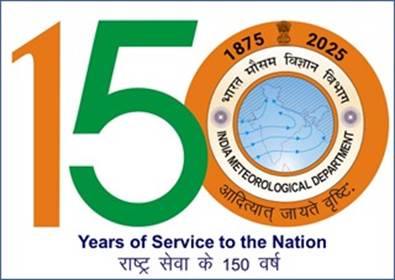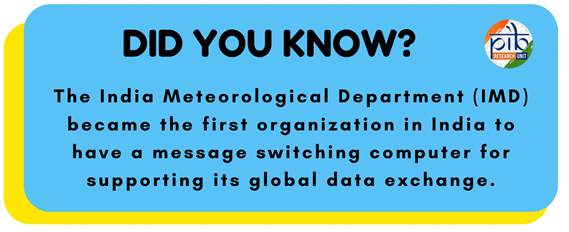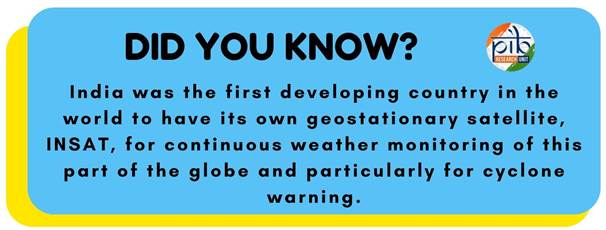
The India Meteorological Department (IMD), under the Ministry of Earth Sciences, marks a significant milestone as it celebrates 150 years of dedicated service to the nation. Established in 1875, IMD has been at the forefront of providing critical weather and climate services, playing a vital role in disaster management, agriculture, aviation, and public safety. As the National Meteorological Service of India, IMD has been at the forefront of meteorology, seismology, and allied disciplines, playing an integral role in safeguarding lives, supporting economic development, and advancing scientific research for societal benefit.

IMD at 150 years
Prime Minister Shri Narendra Modi graced the 150th Foundation Day celebrations of the India Meteorological Department (IMD) on January 14, 2025, at Bharat Mandapam, New Delhi. Highlighting IMD's remarkable journey, the Prime Minister noted that its 150-year legacy symbolizes India's progress in modern science and technology. On this historic occasion, he launched ‘Mission Mausam,’ an initiative aimed at transforming India into a ‘Weather-ready and Climate-smart’ nation through advanced weather surveillance technologies, high-resolution atmospheric observations, next-generation radars, satellites, and high-performance computing systems.[1]
The Prime Minister also unveiled a commemorative postage stamp and coin, alongside releasing the IMD Vision-2047 document, which outlines a roadmap for weather resilience and climate change adaptation as India prepares to mark 100 years of independence in 2047. The event featured workshops and activities showcasing IMD’s contributions to making India climate-resilient and providing critical weather and climate services. Celebrating 150 years of IMD reflects not just a milestone for the department but also India’s commitment to harnessing science for societal progress.
IMD: Origin and Significance
The India Meteorological Department (IMD) was established in 1875, following a series of catastrophic events that underscored the need for centralized meteorological services. Among these, a devastating tropical cyclone struck Calcutta in 1864, followed by monsoon failures in 1866 and 1871, highlighting the vulnerabilities of the Indian subcontinent to weather extremes.

IMD's establishment marked a pivotal moment in the development of meteorology in India, bringing all meteorological work under a unified authority. Since its inception, the department has played a crucial role in advancing meteorology as a modern physical science. It has continually upgraded its capabilities, employing cutting-edge technology and research to enhance weather forecasting, climate monitoring, and disaster preparedness.

IMD's services have been instrumental in mitigating the impact of natural disasters, supporting agriculture, water management, aviation, and other sectors, and contributing to the socio-economic development of India and the broader region. Today, it stands as a cornerstone institution in weather and climate services, driving resilience and sustainability in the face of climate challenges.
IMD: Achievements and Advancements
IMD has made significant advancements since its inception, reflecting its commitment to innovation and service enhancement. Key achievements include:
Pioneering Weather Observations
- By 2023, IMD has replaced all Mercury Barometers with Digital Barometers by the UNEP Minamata convention (as mercury is hazardous to human health) at all Class I observatories.
- Enhanced agro-meteorological services with the deployment of 200 AGRO AWS stations.
- Sustenance of 25 GPS based PB Stations in which 5 stations equipped with IMD manufactured and 20 are outsourced from Indian manufactures.
Communication and Outreach
- India Meteorological Department launched its Crowdsource web interface in January 2021 and the mobile App "Public Observation” on 14th January, 2022 to allow users to provide their weather feedback at anytime from anywhere.
- Crowd sourcing: Since 2021, IMD has started an online interface to collect the information of the weather that has occurred as well as the associated impact information for six weather events initially, viz., Rain. Hail, Duststorm, Wind Speed, Thunderstorm/Lightning & Fog.
Advances in Numerical Weather Prediction
- Overall Forecast Accuracy witnessed a 40% improvement in 2023 as compared to 2014.
- Expansion of Doppler Weather Radar (DWR) network from 15 in 2014 to 39 in 2023 with land area of coverage increased by about 35% from 2014.
- The successful prediction of cyclones like Phailin (2013), Hudhud (2014), Fani (2019), Amphan (2020), Tauktae (2021), Biparjoy (2023), and Dana (2024) has demonstrated our capabilities and the value of our services in saving lives and reducing economic losses.
- With the accurate cyclone warning by IMD, the number of deaths has reduced from 10,000 in 1999 to Zero in 2020-2024
Technological Advancements
- High-Resolution Rapid Refresh (HRRR) model for Nowcasting of Rainfall & Reflectivity forecasts.
- Electric Weather Research and Forecasting (EWRF) model for Nowcast of Lightning density & Accumulated Rainfall forecasts
- Mausamgram, an interactive and dynamic meteogram which provides location specific weather forecast information was released on 15-01-2024 during the IMD’s 150th foundation celebration day by the Vice President of India to the public usage
- Increase in the number of Automatic Rain Gauges (ARG) from 1350 in 2014 to 1382 in 2023.
- Increase in the number of District-wise Rainfall Monitoring Scheme (DRMS) stations from 3955 in 2014 to 5896 in 2023.
Make in India Initiative
- IMD has been the front runner of the development of Indigenous technology, commencing with indigenous RADAR in 1958, and Indian Satellite products in collaboration with ISRO since 1983. Automatic Weather Station since 2000, Doppler Weather Radar since 2010, Common Alerting Protocol since 2019, Impact based Forecast since 2019, Dynamic composite risk atlas since 2022.
A Legacy of Excellence
As IMD celebrates its 150th anniversary, its legacy as a cornerstone of India's development and safety is undeniable. From pioneering meteorological research to adopting state-of-the-art technology, IMD continues to evolve, ensuring its services remain relevant and impactful in an era of climate change and increasing weather unpredictability. With its unwavering commitment to innovation and service, IMD stands as a testament to the nation’s progress and resilience.
References
Annual Report: https://metnet.imd.gov.in/phps/imdweb_imdarep.php
https://mausam.imd.gov.in/event/curtain_raiser_2025.php
Achievements in Last Decade PDF: https://mausam.imd.gov.in/event/curtain_raiser_2025.php
https://mausam.imd.gov.in/responsive/imdBroucher.php
https://pib.gov.in/PressReleasePage.aspx?PRID=1990555
https://pib.gov.in/PressReleasePage.aspx?PRID=2092716
*****
